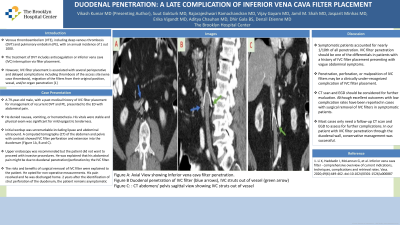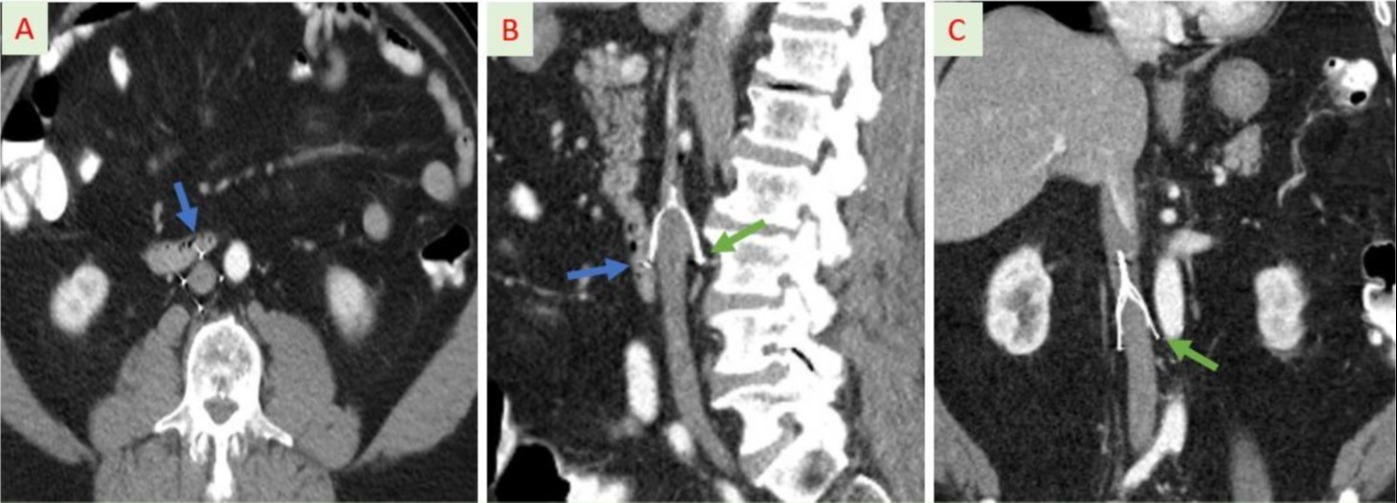Back


Poster Session A - Sunday Afternoon
Category: Small Intestine
A0669 - Duodenal Penetration: A Late Complication of Inferior Vena Cava Filter Placement
Sunday, October 23, 2022
5:00 PM – 7:00 PM ET
Location: Crown Ballroom

Has Audio

Vikash Kumar, MD
The Brooklyn Hospital Center
Brooklyn, NY
Presenting Author(s)
Vikash Kumar, MD1, Suut Gokturk, MD1, Rajarajeshwari Ramachandran, MD1, Vijay Gayam, MD1, Jamil M. Shah, MD1, Jasparit Minhas, MD1, Erika Vigandt, MD1, Aditya Chauhan, MD1, Dhir Gala, BS2, Denzil Etienne, MD1
1The Brooklyn Hospital Center, Brooklyn, NY; 2American University of the Caribbean School of Medicine, Brooklyn, NY
Introduction: Venous thromboembolism (VTE), including deep venous thrombosis (DVT) and pulmonary embolism (PE), with an annual incidence of 1 out 1000. The treatment of DVT includes anticoagulation or inferior vena cava (IVC) interruption via filter placement. However, IVC filter placement is associated with several perioperative and delayed complications including thrombosis of the access site (vena cava thrombosis), migration of the filters from their original position, vessel, and/or organ penetration [1].
Case Description/Methods: A 79-year-old male, with a past medical history of IVC filter placement for management of recurrent DVT and PE, presented to the ED with abdominal pain. He denied nausea, vomiting, or hematochezia. His vitals were stable and physical exam was significant for mild epigastric tenderness. Initial workup was unremarkable including lipase and abdominal ultrasound. A computed tomography (CT) of the abdomen and pelvis with contrast showed IVC filter perforation and extension into the duodenum (Figure 1A, B and C). Upper endoscopy was recommended but the patient did not want to proceed with invasive procedures. He was explained that his abdominal pain might be due to duodenal penetration/perforation by the IVC filter. The risks and benefits of surgical removal of IVC filter were explained to the patient. He opted for non-operative measurements. His pain resolved and he was discharged home. 2 years after the identification of strut perforation of the duodenum, the patient remains asymptomatic.
Discussion: Penetration, perforation, or malposition of IVC filters may be a clinically under-recognized complication of IVC filter placement. Symptomatic patients accounted for nearly 1/10th of all penetration. IVC filter penetration should be one of the differentials in patients with a history of IVC filter placement presenting with vague abdominal symptoms. CT scan and EGD should be considered for further evaluation. Although excellent outcomes with low complication rates have been reported in cases with surgical removal of IVC filters in symptomatic patients. Most cases only need a follow-up CT scan and EGD to assess for further complications. In our patient with IVC filter penetration through the duodenal wall, conservative management was successful.
1. Li X, Haddadin I, McLennan G, et al. Inferior vena cava filter - comprehensive overview of current indications, techniques, complications and retrieval rates. Vasa. 2020;49(6):449-462. doi:10.1024/0301-1526/a000887

Disclosures:
Vikash Kumar, MD1, Suut Gokturk, MD1, Rajarajeshwari Ramachandran, MD1, Vijay Gayam, MD1, Jamil M. Shah, MD1, Jasparit Minhas, MD1, Erika Vigandt, MD1, Aditya Chauhan, MD1, Dhir Gala, BS2, Denzil Etienne, MD1. A0669 - Duodenal Penetration: A Late Complication of Inferior Vena Cava Filter Placement, ACG 2022 Annual Scientific Meeting Abstracts. Charlotte, NC: American College of Gastroenterology.
1The Brooklyn Hospital Center, Brooklyn, NY; 2American University of the Caribbean School of Medicine, Brooklyn, NY
Introduction: Venous thromboembolism (VTE), including deep venous thrombosis (DVT) and pulmonary embolism (PE), with an annual incidence of 1 out 1000. The treatment of DVT includes anticoagulation or inferior vena cava (IVC) interruption via filter placement. However, IVC filter placement is associated with several perioperative and delayed complications including thrombosis of the access site (vena cava thrombosis), migration of the filters from their original position, vessel, and/or organ penetration [1].
Case Description/Methods: A 79-year-old male, with a past medical history of IVC filter placement for management of recurrent DVT and PE, presented to the ED with abdominal pain. He denied nausea, vomiting, or hematochezia. His vitals were stable and physical exam was significant for mild epigastric tenderness. Initial workup was unremarkable including lipase and abdominal ultrasound. A computed tomography (CT) of the abdomen and pelvis with contrast showed IVC filter perforation and extension into the duodenum (Figure 1A, B and C). Upper endoscopy was recommended but the patient did not want to proceed with invasive procedures. He was explained that his abdominal pain might be due to duodenal penetration/perforation by the IVC filter. The risks and benefits of surgical removal of IVC filter were explained to the patient. He opted for non-operative measurements. His pain resolved and he was discharged home. 2 years after the identification of strut perforation of the duodenum, the patient remains asymptomatic.
Discussion: Penetration, perforation, or malposition of IVC filters may be a clinically under-recognized complication of IVC filter placement. Symptomatic patients accounted for nearly 1/10th of all penetration. IVC filter penetration should be one of the differentials in patients with a history of IVC filter placement presenting with vague abdominal symptoms. CT scan and EGD should be considered for further evaluation. Although excellent outcomes with low complication rates have been reported in cases with surgical removal of IVC filters in symptomatic patients. Most cases only need a follow-up CT scan and EGD to assess for further complications. In our patient with IVC filter penetration through the duodenal wall, conservative management was successful.
1. Li X, Haddadin I, McLennan G, et al. Inferior vena cava filter - comprehensive overview of current indications, techniques, complications and retrieval rates. Vasa. 2020;49(6):449-462. doi:10.1024/0301-1526/a000887

Figure: Figure 1: Duodenal penetration of IVC filter (blue arrows), IVC struts out of vessel (green arrow)
Disclosures:
Vikash Kumar indicated no relevant financial relationships.
Suut Gokturk indicated no relevant financial relationships.
Rajarajeshwari Ramachandran indicated no relevant financial relationships.
Vijay Gayam indicated no relevant financial relationships.
Jamil Shah indicated no relevant financial relationships.
Jasparit Minhas indicated no relevant financial relationships.
Erika Vigandt indicated no relevant financial relationships.
Aditya Chauhan indicated no relevant financial relationships.
Dhir Gala indicated no relevant financial relationships.
Denzil Etienne indicated no relevant financial relationships.
Vikash Kumar, MD1, Suut Gokturk, MD1, Rajarajeshwari Ramachandran, MD1, Vijay Gayam, MD1, Jamil M. Shah, MD1, Jasparit Minhas, MD1, Erika Vigandt, MD1, Aditya Chauhan, MD1, Dhir Gala, BS2, Denzil Etienne, MD1. A0669 - Duodenal Penetration: A Late Complication of Inferior Vena Cava Filter Placement, ACG 2022 Annual Scientific Meeting Abstracts. Charlotte, NC: American College of Gastroenterology.
